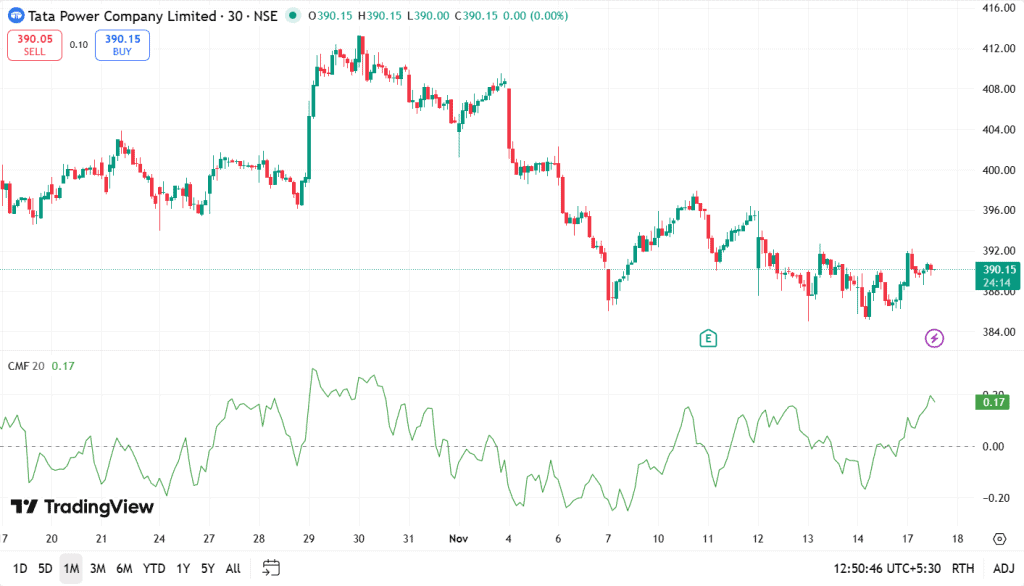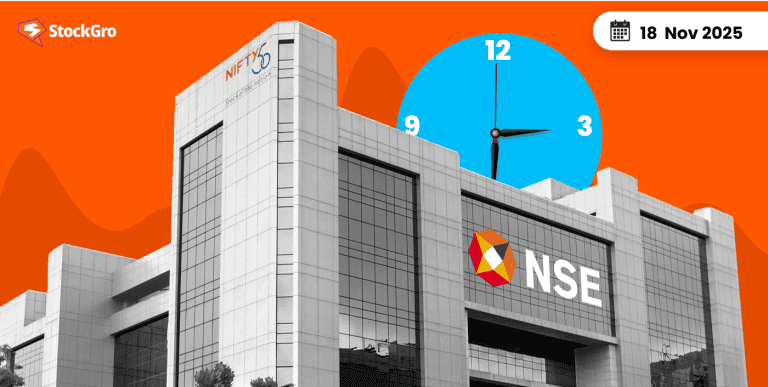
Price charts, by themselves, are rarely enough to convey the complete picture. A stock can look strong on the surface level while money quietly exits in the background or appear weak while buyers build positions. That hidden push-and-pull between the buying and selling pressure is exactly what the Chaikin Money Flow (CMF) helps to uncover.
Chaikin Money Flow (CMF) is an indicator in technical analysis, which measures the buying and selling pressure of a stock by combining its price and volume. It acts like an early warning system. It shows whether a trend has a real strength behind it, and helps in confirming if a breakout is trustworthy, and highlights moments when the price and volume aren’t moving in sync.
Understanding the Chaikin Money Flow (CMF) indicator provides investors and traders with a sharper read on conviction, helps them to avoid false signals, and makes more confident entries and exits. Read this blog to understand the Chaikin Money Flow (CMF) indicator, how it is calculated, how to implement it in trading strategies, and more.
What is the Chaikin Money Flow (CMF) Indicator?
Chaikin Money Flow (CMF) indicator is a tool used in technical analysis, which measures the buying and selling pressure of a stock by combining its price and volume over a period of time.
The CMF indicator incorporates price and volume to analyse whether money is flowing into the security or out of the security. It compares the closing price of a stock to the period’s high-low range, and a close near the high suggests buying pressure, while a close near the low indicates selling pressure.
How the Chaikin Money Flow is Calculated
To calculate the Chaikin Money Flow (CMF), the following steps and formulas are implemented:
| Steps | Process | Formula |
| Step-1 | Calculating Money Flow Multiplier (MFM) | [(Close – Low) – (High – Close)] / (High – Low) |
| Step-2 | Calculating Money Flow Volume (MFV) | MFM x Volume |
| Step-3 | Calculating Chaikin Money Flow (CMF) | Sum of MFV for the period / Sum of Volume for the period |
Let’s have a clear understanding of CMF with an example CMF calculation for a 3-day period!
| Day | High | Low | Close | MFM | Volume | MFV | 3-Day Period CMF |
| Day-1 | 110 | 100 | 108 | 0.6 | 1,00,000 | 60,000 | – |
| Day-2 | 112 | 105 | 107 | (0.43) | 80,000 | (34,400) | – |
| Day-3 | 115 | 110 | 114 | 0.6 | 1,20,000 | 72,000 | 0.32 |
Day-1:
MFM = (108 – 100 – (110 – 108)) / 110 – 100 = 0.6
MFV = 0.6 × 1,00,000 = 60,000
Day-2:
MFM = (107 – 105 – (112 – 107)) / 112 – 105 = –0.43
MFV = –0.43 × 80,000 = –34,400
Day-3:
MFM = (114 – 110 – (115 – 114)) / 115 – 110 = 0.6
MFV = 0.6 × 1,20,000 = 72,000
Now, here is how the calculation goes for CMF, for the 3-day period:
Sum of MFV = 60,000 – 34,400 + 72,000 = 97,600
Sum of Volume = 1,00,000 + 80,000 + 1,20,000 = 3,00,000
CMF = 97,600 / 3,00,000 = 0.32 Approximately
Typical settings (period, lookback)
The default or common look-back period for Chaikin Money Flow is 20-21 days. It ranges within +1 and -1. The positive value suggests buying pressure, while the negative value suggests selling pressure.
How to Use CMF in Your Trading Strategy
Let’s see how traders can incorporate CMF in their trading strategy to identify buying or selling signals and potential trend reversals.
Entry & exit signals (zero-line cross, divergence)
- Zero-line crossover: If the CMF crosses over the zero line, a bullish entry signal is indicated with an increasing bullish momentum. And if the CMF crosses under the zero line, there is a bearish exit or entry signal.
- Divergence: The traders might look for a divergence between the price and the CMF to identify reversals. A weak selling pressure is indicated in case of a bullish divergence, when price falls but CMF rises, while a weak buying pressure is indicated by a bearish divergence, when price rises but CMF weakens.
Confirmation with other indicators (RSI, MACD, trend)
- Combine with RSI: The CMF could be used in conjunction with the RSI. For example, a CMF crossover above the zero line combined with an RSI moving up from oversold territory can provide a stronger buy signal.
- MACD crossover confirmation: The traders can also use the MACD to confirm CMF signals. In a bullish CMF crossover, they might look for confirmation from a bullish MACD crossover or for the MACD to be trending upwards.
- Trend confirmation: In an Uptrend, if the price is above, let’s say, the 200-day moving average, traders might look for long opportunities during bullish CMF crossovers. And in the same way, in a downtrend, when the price is under the 200-day moving average, they might look for short opportunities during bearish CMF crossovers.
CMF vs Other Indicators
Next, let’s understand how Chaikin Money Flow indicators differ from Money Flow Index, and other volume-based indicators such as OBV and A/D.
Difference between CMF and MFI
| Feature | Chaikin Money Flow (CMF) | Money Flow Index (MFI) |
| Function | It measures the volume-weighted flow of money over a period, and indicates accumulation and distribution. | It measures momentum based on the price and volume to identify over-bought or over-sold scenarios. |
| Calculation | It focuses on where a stock closes compared to its high-low range, then multiplies it by volume. | It uses the price and volume to calculate the relationship between a positive and negative money flow. |
| Indicator of | Accumulation/distribution | Momentum oscillator |
| Use Case | It helps in identifying trend reversals or confirming the strength of a trend. | It helps in identifying price reversals or corrections. |
CMF and other volume-based indicators (OBV, A/D)
| Feature | Chaikin Money Flow(CMF) | On-Balance Volume(OBV) | Accumulation / Distribution(A/D) |
| Function | It measures volume-weighted flow of money by focusing on the closing position within the day’s range. | It measures the flow of volume, by adding the volume of days when the prices increase and subtracting the volume of days when the price decreases. | It measures the cumulative flow of volume, by giving more weight to high-volume days. |
| Calculation | It focuses on the closing position in comparison to the high-low range, then multiplied by the volume. | It compares the closing price to the previous day’s closing price to calculate volume flow. | It tracks the cumulative flow of money by using the closing price position within the day’s range, multiplied by volume. |
| Sensitivity | It is more sensitive to how the price and volume moves. | It can produce more false signals because it relies on the difference in closing prices over multiple days. | Its sensitivity is similar to CMF, as it is derived from how the closing price relates to the high-low range. |
| Use case | It helps in identifying the trend’s strength and reversals | It helps in identifying divergences between the price and volume, and confirm or anticipate a trend. | It helps in confirming trends and identifying reversals by showing money flowing into or out of a security. |
Practical Examples & Case Studies
Let’s see a practical example of Chaikin Money Flow using Tata Power Company Limited’s 1-month chart in a 30-minute interval.

In this chart, Tata Power initially moves through a clear downtrend, and the CMF, represented by the green line, stays below zero during this phase, indicating that most of the activity is happening on the sell side. Later, the price begins to rise slightly. And, at the same time, the CMF shifts above zero and stays positive, indicating that the buyers are becoming more active.
In such situations, the traders might read a negative CMF as a confirmation of selling pressure during declines, and a positive CMF as an early sign of accumulation when prices start to base or recover.
Common mistakes & limitations of the CMF indicator
- Susceptible to false signals in volatile markets: The CMF might generate misleading signals, known as whipsaws, in the case of sideways or choppy markets where no clear trend is established, which might lead a trader into a position that quickly reverses, resulting in potential losses.
- Lagging indicator based on historical data: The CMF uses past price and volume data for its calculations, which means it will always be a step behind the current price movements. It might cause traders to enter a trade after a portion of the move has already occurred, leading to missed opportunities or poor entry or exit points.
- Calculation doesn’t fully account for price gaps: The CMF’s money flow multiplier is based on where the price closes within its daily range, and a large price gap from the previous day’s close is not fully incorporated into the current day’s calculation. It might distort the indicator’s reading, for example, showing strong buying pressure.
Bottom line
The Chaikin Money Flow (CMF) indicator sharpens the traders’ or investors’ view of what’s happening under the surface level of a price move. The CMF, by combining the price and volume, reveals whether a trend is supported by real conviction or if something is off. When used with other indicators and proper risk management, it can help traders filter noise, identify stronger signals, and avoid impulsive decisions in fast-moving markets.
FAQ‘s
The Chaikin Money Flow (CMF) indicator is a technical analysis tool that combines a stock’s price and volume over a period of time to measure its buying and selling pressure. It compares the closing price of a stock to the period’s high-low range, and a close near the high suggests buying pressure, while a close near the low indicates selling pressure.
The Chaikin Money Flow is useful for reading the buying and selling pressure. However, the accuracy depends on the market conditions. It performs better in the trending markets and might provide false signals during sideways or highly volatile conditions.
The Chaikin Money Flow indicator can be used for both intraday trading and long-term periods. The traders might apply shorter look-back periods, while positional traders might prefer the standard ‘20–21 days’ setting for a smoother read.
Traders can use the CMF indicator to watch for zero-line crossovers, divergences, and confirmation with trend or momentum indicators. These signals help them in identifying entries, exits, and reversals.
The CMF indicator tracks the accumulation and distribution based on the price-volume behaviour, while the MFI is a momentum oscillator that highlights overbought and oversold areas. They serve different purposes but can complement each other for analysing the strength of a trend.
